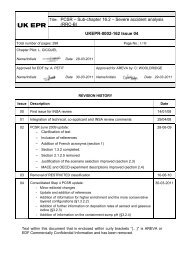Level 3 PSA - EDF Hinkley Point
Level 3 PSA - EDF Hinkley Point
Level 3 PSA - EDF Hinkley Point
Create successful ePaper yourself
Turn your PDF publications into a flip-book with our unique Google optimized e-Paper software.
HPC-NNBOSL-U0-000-RES-000028 Version 1.0<br />
<strong>Level</strong> 3 <strong>PSA</strong><br />
NOT PROTECTIVELY MARKED<br />
Accident group Risk (y -1 ) % of total risk<br />
<strong>Level</strong> 1 <strong>PSA</strong> (non-core damage)* 1.5E-07 40.4<br />
PCC (not in <strong>Level</strong> 1 <strong>PSA</strong>)* 1.0E-07 28.6<br />
EXRV2 2.2E-08 6.1<br />
ADRV 0.0E+00 0.0<br />
<strong>Level</strong> 2 <strong>PSA</strong> (core damage) 4.5E-08 12.4<br />
LOSAs 4.6E-08 12.6<br />
Total 3.6E-07 100.0<br />
Table 3 – Risk Contribution by Accident Group<br />
The additional accidents identified from the Expert Review of the GDA <strong>PSA</strong> (EXRV<br />
group) can also be seen not to make a significant contribution to the risk, indicating that<br />
the accident sequences identified for the <strong>PSA</strong> and PCC analysis were reasonably<br />
comprehensive in relation to risk to workers as well as off-site risk.<br />
5.6.2 Risk Assessment for Other Worker Cohort Groups<br />
As previously discussed two other worker cohorts have been defined in addition to the<br />
generic worker. These are the Fuel Building and Main Control Room (MCR) worker<br />
cohorts. Considering the hierarchy of dominant accidents and their relative Occupancy<br />
Factor for a generic worker these two other cohorts are the most relevant to check that<br />
the most at risk individual on site has been assessed. The overall risk for these groups<br />
has been assessed separately and can be compared against the assessed risk for the<br />
generic worker cohort.<br />
5.6.2.1 Main Control Room (MCR) Worker Cohort<br />
This worker cohort represents workers in the MCR. This worker cohort is assumed to<br />
spend all of their time whilst on-site in the MCR and not to spend any time in other plant<br />
areas [AS-013]. As this group of workers is assumed to have to remain in the MCR in<br />
the event of an accident, they are assumed to have a maximum likelihood of being<br />
exposed to the on-site consequences of accidents anywhere on site, including severe<br />
accidents. Therefore, the risk to this group of workers is comprised of the risk from the<br />
<strong>Level</strong> 2 <strong>PSA</strong> core damage accidents and the off-site consequences [AS-008] of the<br />
<strong>Level</strong> 1 <strong>PSA</strong>, PCC and expert review accidents. In all cases the occupancy factor for<br />
exposure of MCR workers to these accidents is assumed to be unity.<br />
For MCR workers only the overall risk figure for comparison against SDO-4 is presented<br />
in Section 5.6.3 and Section 5.6.4, both with and without the contribution from LOSAs.<br />
5.6.2.2 Fuel Building Worker Cohort<br />
This worker cohort represents a specific group of workers who work exclusively in the<br />
fuel building whilst on-site and who do not spend any of their time in any other areas<br />
[AS-012]. As such, this group will have the maximum likelihood of exposure to accidents<br />
involving fuel handling and accidents involving the spent fuel pool. This cohort will<br />
therefore have an occupancy factor of unity for all fuel building accidents and an<br />
occupancy factor of zero for all other accidents. A list of the accidents for which the Fuel<br />
Building worker cohort is assumed to be affected is given in Table 4 below.<br />
2 Including both local and on-site risk<br />
UNCONTROLLED WHEN PRINTED<br />
NOT PROTECTIVELY MARKED<br />
Page 26 of 60














![6.3 - Safety Injection System (RIS [SIS]) - EDF Hinkley Point](https://img.yumpu.com/42739985/1/184x260/63-safety-injection-system-ris-sis-edf-hinkley-point.jpg?quality=85)


